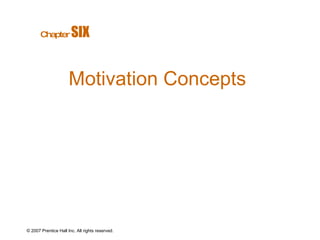
Ob12 06st
- 1. © 2007 Prentice Hall Inc. All rights reserved. Motivation Concepts Chapter SIX
- 2. © 2007 Prentice Hall Inc. All rights reserved. What Is Motivation? Persistence Intensity Direction
- 5. Maslow’s Hierarchy of Needs E X H I BI T 6 –1 Lower-Order Needs Needs that are satisfied externally; physiological and safety needs. Higher-Order Needs Needs that are satisfied internally; social, esteem, and self-actualization needs.
- 7. © 2007 Prentice Hall Inc. All rights reserved. Theory X Managers See Workers As… Disliking Work Avoiding Responsibility Having Little Ambition Theory Y Managers See Workers As… Enjoying Work Accepting Responsibility Self-Directed
- 9. Comparison of Satisfiers and Dissatisfiers © 2007 Prentice Hall Inc. All rights reserved. Factors characterizing events on the job that led to extreme job dissatisfaction Factors characterizing events on the job that led to extreme job satisfaction E X H I B I T 6 –2 Source: Reprinted by permission of Harvard Business Review . An exhibit from One More Time: How Do You Motivate Employees? by Frederick Herzberg, September–October 1987. Copyright © 1987 by the President and Fellows of Harvard College: All rights reserved.
- 10. Contrasting Views of Satisfaction and Dissatisfaction © 2007 Prentice Hall Inc. All rights reserved. E X H I B I T 6 –3
- 11. David McClelland’s Theory of Needs © 2007 Prentice Hall Inc. All rights reserved. Need for Achievement The drive to excel, to achieve in relation to a set of standards, to strive to succeed. Need for Affiliation The desire for friendly and close personal relationships. Need for Power The need to make others behave in a way that they would not have behaved otherwise. Bottom Line: Individuals have different levels of needs in each of these areas, and those levels will drive their behavior
- 12. Matching High Achievers and Jobs © 2007 Prentice Hall Inc. All rights reserved. E X H I B I T 6 –4
- 13. Cognitive Evaluation Theory © 2007 Prentice Hall Inc. All rights reserved. Cognitive Evaluation Theory Providing an extrinsic reward for behavior that had been previously only intrinsically rewarding tends to decrease the overall level of motivation. The theory may only be relevant to jobs that are neither extremely dull nor extremely interesting. Hint: For this theory, think about how fun it is to read in the summer, but once reading is assigned to you for a grade, you don’t want to do it!
- 14. © 2007 Prentice Hall Inc. All rights reserved. E X H I B I T 6 –5 What Would Herzberg Say? What Would Maslow Say?
- 18. Cascading of Objectives © 2007 Prentice Hall Inc. All rights reserved. E X H I B I T 6 –1
- 19. Linking MBO and Goal-Setting Theory © 2007 Prentice Hall Inc. All rights reserved. MBO Goal-Setting Theory Goal Specificity Yes Yes Goal Difficulty Yes Yes Feedback Yes Yes Participation Yes No (qualified)
- 22. Self-Efficacy and Goal Setting © 2007 Prentice Hall Inc. All rights reserved.
- 26. Equity Theory (cont’d) © 2007 Prentice Hall Inc. All rights reserved. E X H I B I T 6 –8
- 29. Justice and Equity Theory © 2007 Prentice Hall Inc. All rights reserved.
- 30. Three types of Justice © 2007 Prentice Hall Inc. All rights reserved. Distributive Justice Perceived fairness of the outcome (the final distribution). “ Who got what?” Procedural Justice The perceived fairness of the process used to determine the outcome (the final distribution). “How was who gets what decided?” Interactional Justice The degree to which one is treated with dignity and respect. “ Was I treated well?”
- 32. © 2007 Prentice Hall Inc. All rights reserved. Putting It All Together
Notas do Editor
- Motivation is the process that accounts for an individual’s intensity, direction, and persistence of effort toward the attainment of a goal. Intensity is concerned with how hard a person tries. This is the element most of us focus on when we discuss the topic of motivation. However, unless effort is channeled in a direction that benefits the organization, high intensity is no guarantee of favorable job-performance outcomes. Quality of effort, therefore, is just as important as intensity of effort. Finally, persistence (how long a person can maintain effort) is important. A motivated person stays with a task long enough to achieve his or her goal.
- Douglas McGregor said that managers hold one of two sets of assumptions about human nature: either Theory X or Theory Y. Seeing people as irresponsible and lazy, managers who follow Theory X assume the following: 1. Employees inherently dislike work and will try to avoid it. 2. Since employees dislike work, they must be coerced, controlled, or threatened to achieve goals. 3. Employees avoid responsibilities and seek formal direction, if possible. 4. Most workers place security above all other work-related factors and will display little ambition. Since they see people as responsible and conscientious, managers who follow Theory Y assume the following: 1. Employees can view work as being as natural as rest or play. 2. When committed to their objectives, people will exercise self-direction and self-control 3. The average person can learn to accept, even seek, responsibility. 4. Many workers besides managers have innovative decision-making skills. No hard evidence confirms that either set of assumptions is universally true. It is more likely that the assumptions of Theory X or Theory Y may or may not be appropriate, depending on the situation at hand.
